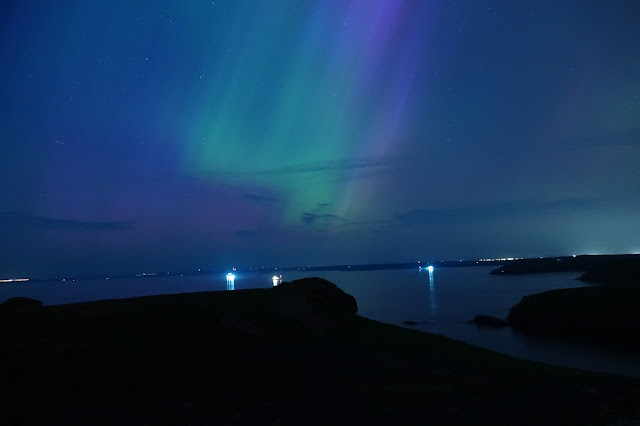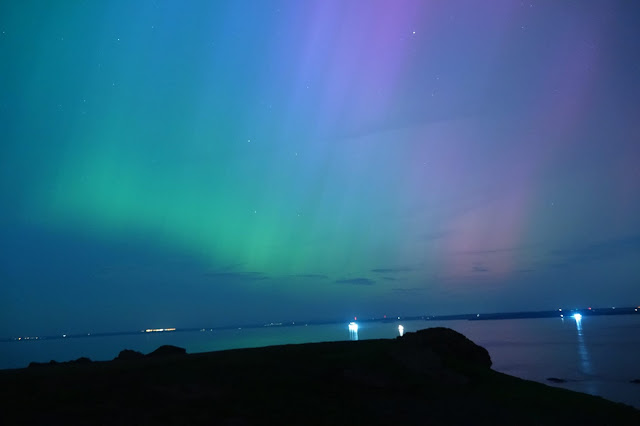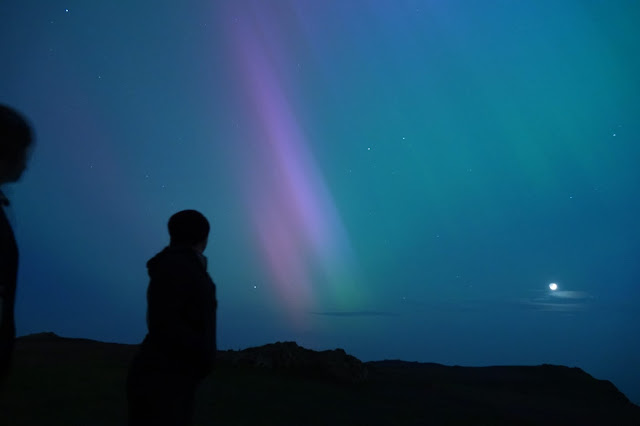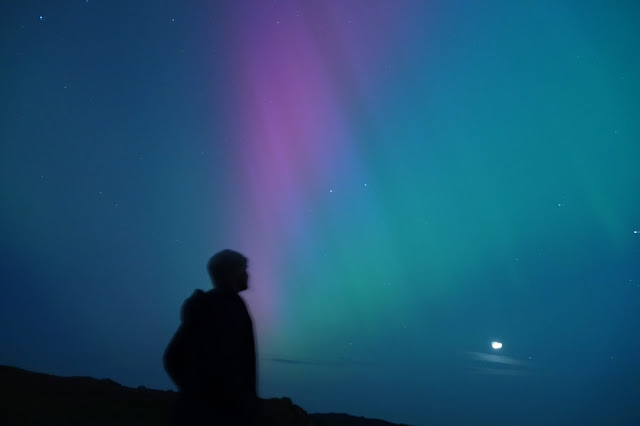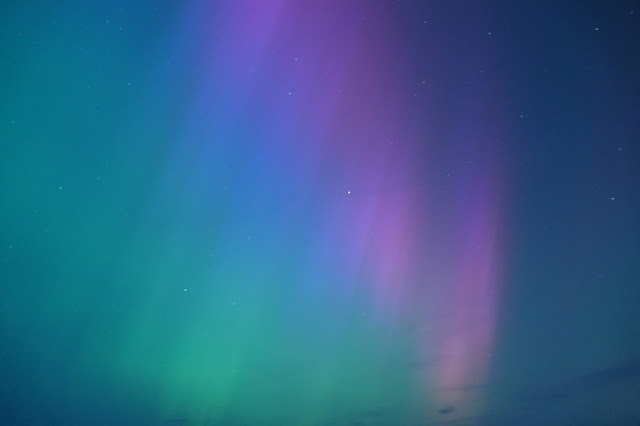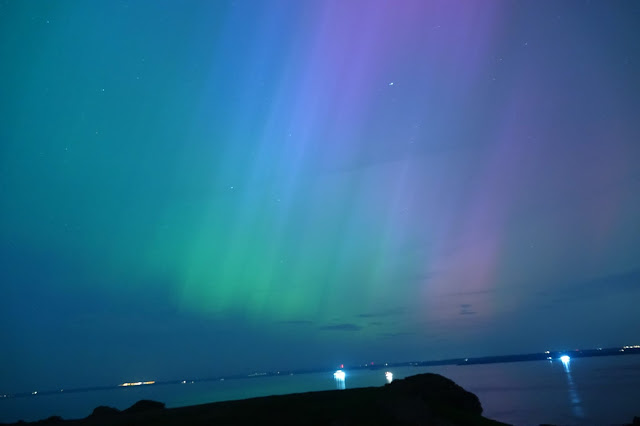We are honoured once again be be asked to write a guest blog of our annual pilgrimage to Skomer to count the Lesser Black-backed Gulls.
The weather forecast looked good
for the 6 days, in fact it looked brilliant, lots of blue skies and
south-easterly winds, it looked perfect for counting, and more than pretty good
for the chance of some scarce birds.
But at the end of the day, we were
here to count gulls, not find rare birds …………
Great news on arrival, we didn’t even have to carry our obscenely heavy rucksacks up the steps, as we met Leighton and some of the team. We used the wheelbarrows to get some of our stuff to the farm, as we noticed how incredibly green the island was after the wet spring.
At the farm we unpacked as little as possible but still missed a Grey Plover flying over in doing so!
We talked through the gull counts with Leighton and met Ceris and the rest of the team- just how wonderful was it to be back 😊
We loaded up the rucksack with food, drink and maps and we were off counting.
The counting went really well on the first day with beautiful sunshine and the smell of sea air and flowers filling our nostrils constantly – bliss.
Ted picked up 4 Red Kites over the
Amos just after midday, and in the afternoon a stunning male White Wagtail, in
the evening 3 Collared Doves arrived at the farm.
Counting LBB’s
So just a brief idea of what we and
the island staff do to count the gulls.
The whole island is one colony of
LBB’s, it is then divided into sub-colonies which stay the same each year with
minor fluctuations in size/ shape, then there are fixed points to view each
sub-colony from. Ted and I go to those fixed points and count how many birds
are actually on nests/ nesting, these are called the eye counts.
The team then use a
correction factor (gained over many years of study) and apply it to our gull
counts to give the overall figure.
Friday May 10th
A day we will simply never forget,
and it wasn’t because of a rare bird.
We were continuing with the counts but obviously ‘migrant bashing’ early morning and evening.
It didn’t take long as at 7am Ted
found a 1st summer male Black Redstart at the Chicken Sheds that
rapidly moved to the farm, ultimately staying for a couple of days.
Photo 1 – Black Redstart by Ted.
We bashed around North Valley with little reward and then went to the research hide where soon things livened up as we picked up a Summer Plumaged Great Northern Diver flying north, followed only 9 minutes later by a Red-throated Diver on the same route ! What was going on? We rapidly left the hide and headed for the Garland Stone to see what was passing on the sea, pretty quickly we saw a flock of 10 Common Scoter going south, but no more divers. We needed breakfast!!
Then a ridiculous count of 13 Red Kites in a flock over North Haven/ The Neck, amassing 17 by the afternoon. All immature, most probably 1st summer birds. In the evening a Lesser Whitethroat in north valley.
First a phone call from Leighton,
and then Ceris hammering on our door about the northern lights. We are indebted
to you - forever !!!!!
.JPG) |
Pictures of Northern Lights by Ted.
Saturday 11th May
After the divers the day before we were obviously going seawatching early morning ! No divers or much else to be honest, but we did get a nice Great Skua passing between Skomer and Skokholm. We headed back for breakfast, and then it really kicked off ……
A scan of the west fields picked up
a smallish wader flying at us, possibly having come up from the area west of
North pond. I shouted to Ted and we were both locked on, different species flew
through my head, as all I could really see was a really bright red/ orange
belly, Bar-tailed Godwit ?, nope too small, Curlew Sandpiper ? Nope, then we
both clicked and both screamed ‘Dotterel’. Nearly 30 years in the making, and
simply one of my dream birds for Skomer, and it was flying virtually straight
at us. The cameras went mad, we went mad. It flew past us, at which point my
arms and legs felt like jelly, the adrenalin rush was intense. It turned
towards Moorey Mere and we were willing it to come down, I picked up the phone
to Leighton. Leighton and Ceris were on the ‘Gator’, I subsequently found out
that Leighton practiced an Emergency Stop ! Sorry to say they didn’t see it.
Ted and I were in shock, overjoyed, big fist pumps and hugs ensued. A magical
moment, an incredible memory 😊
Photo of Dotterel by Mike
The Red Kites continued, we saw 16 together over the farm, although Dave (Astins) saw 23 over Skomer from the Deer Park.
Photo of ringed G:U by Mike
This bird was ringed as a chick (male) in a nest on a rooftop in Bristol in 2007, it has been seen on Skomer before, in mid July 2021. Most interestingly he spends his winters on the Algarve in Portugal, having been seen there many times between 2009 and 2024 (Info courtesy of Peter Rock).
Sunday 12th May
I was up early enjoying the sunrise, which was beautiful as it rose through the carpet of bluebells and Campion ……
 |
Sunrise Photo by Mike
Black Redstart video by Mike - a beautiful sounding call as filmed in the courtyard.
Redstart Photo by Mike
A walk in the evening and a methodical count of Spotted Flycatchers from the farm to North Valley resulted in 28 ! There were probably over 40 on the island.
Monday 13th May
We made the most of a dry early
morning, then the storm arrived, and it was a pretty intense storm with very
strong winds and torrential rain. We had to make the most of it, we couldn’t
count, so packed up a bag and went as quickly as we could to the public hide
overlooking north pond. We stayed here for over 4 hrs 😊😊
Was it worth it ? Yes ! As well as
the odd wader and a few swift the highlight was most definitely seeing a female
Gadwall with 11 ducklings.
By tea-time the rain was easing and
we were out walking, we came along the south coast where the sight that greeted
us at the Wick of the Puffins was absolutely amazing. I have never seen so many
here, mind-boggling numbers.
Video of many Puffins on the Wick by Ted.
Tue May 14th
Our last day in paradise.
We did another seawatch, seeing
another Great Northern Diver and watched a Swift arrive from way out to sea
until it passed us within metres at Skomer Head, what incredible birds they
are.
Through the amazing days we spent here on our pilgrimage, we enjoyed the breeding birds on Skomer, other migrants too, the scenery and of course were re-aquainted with good friends and new, wonderful people.
 |
Photo of female Stonechat by Mike |
 |
Photo of Whimbrel by Ted |
 |
Photo of male Stonechat by Ted |








